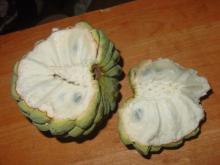The custard apple is a fruit which is a completely common, everyday item to most of the world. But I had never heard about it until I ran across a mention of it today. "CUSTARD apple?" I thought. I understand those two words, but not together.
The custard apple is not an apple. Nor is it custard. It is the fruit of a tree, Annona reticulata, which grows in tropical parts of the world. Originally a native of the tropical islands of the West Indies, it has spread (both in cultivation and as a feral semi-invasive species) throughout Central and South America, from Mexico all the way south to Brazil. It is also found in South Africa, southern India, southeast Asia, and the Philippines.
In America, according to the USDA, the custard apple is grown only in Puerto Rico and the U.S. Virgin Islands. The custard apple's Purdue University page mentions that it is "not well known" in Hawaii, although presumably it would grow well there.
Custard apples are also called "bull's-heart" in various different languages. This speaks to the fruit's size, general shape, and its slight reddish hue. It is related to the cherimoya, and the sugar-apple or sweetsop. (Two other fruits that I had never heard of until today!)
The custard apple is apparently not a big prize, horticulturally speaking. The horticultural department of Purdue University describes the leaves of the custard apple tree as "ill-smelling." They also describe the flesh as being "custardlike, somewhat granular." Delicious?
Purdue University goes on to explain that each tree bears between 75 and 100 pounds of fruit per year. Per YEAR. (An average apple tree produces about 50 pounds of fruit per year. And if you have ever lived with an apple tree, you know that that's an awful lot of fruit.)
Everything about custard apples sounds intriguing and delightful, except that apparently they do not taste very good. "Insipid and blandly sweet" is a typical review. Each segment of the custard apple has several large seeds, which are fairly easy to navigate around (and harmless if swallowed). However, the leaves and skin of the custard apple tree produce a toxin which is effective against lice when applied topically, and against worms if taken internally. Yum?
The custard apple does have one native American cousin, which is the paw-paw fruit. This is an odd tree which is native to the Plains states, primarily Ohio. Called the "prairie banana," the paw-paw fruit is somewhat banana-shaped and -flavored. It too has giant seeds which must be picked out. It provides a surprising amount of nutrition, although its taste is apparently rather bland, as well.
The paw-paw tree is America's largest fruit, but possibly its least-distributed. The fruit goes bad within hours after picking, and if it is picked unripe it will never ripen. Furthermore, the paw-paw tree is sturdy in place, but virtually impossible to move without damaging. This has prevented the paw-paw from showing up in stores, making it one of the few truly local delicacies left in the world.
The custard apple is not an apple. Nor is it custard. It is the fruit of a tree, Annona reticulata, which grows in tropical parts of the world. Originally a native of the tropical islands of the West Indies, it has spread (both in cultivation and as a feral semi-invasive species) throughout Central and South America, from Mexico all the way south to Brazil. It is also found in South Africa, southern India, southeast Asia, and the Philippines.
In America, according to the USDA, the custard apple is grown only in Puerto Rico and the U.S. Virgin Islands. The custard apple's Purdue University page mentions that it is "not well known" in Hawaii, although presumably it would grow well there.
Custard apples are also called "bull's-heart" in various different languages. This speaks to the fruit's size, general shape, and its slight reddish hue. It is related to the cherimoya, and the sugar-apple or sweetsop. (Two other fruits that I had never heard of until today!)
The custard apple is apparently not a big prize, horticulturally speaking. The horticultural department of Purdue University describes the leaves of the custard apple tree as "ill-smelling." They also describe the flesh as being "custardlike, somewhat granular." Delicious?
Purdue University goes on to explain that each tree bears between 75 and 100 pounds of fruit per year. Per YEAR. (An average apple tree produces about 50 pounds of fruit per year. And if you have ever lived with an apple tree, you know that that's an awful lot of fruit.)
Everything about custard apples sounds intriguing and delightful, except that apparently they do not taste very good. "Insipid and blandly sweet" is a typical review. Each segment of the custard apple has several large seeds, which are fairly easy to navigate around (and harmless if swallowed). However, the leaves and skin of the custard apple tree produce a toxin which is effective against lice when applied topically, and against worms if taken internally. Yum?
The custard apple does have one native American cousin, which is the paw-paw fruit. This is an odd tree which is native to the Plains states, primarily Ohio. Called the "prairie banana," the paw-paw fruit is somewhat banana-shaped and -flavored. It too has giant seeds which must be picked out. It provides a surprising amount of nutrition, although its taste is apparently rather bland, as well.
The paw-paw tree is America's largest fruit, but possibly its least-distributed. The fruit goes bad within hours after picking, and if it is picked unripe it will never ripen. Furthermore, the paw-paw tree is sturdy in place, but virtually impossible to move without damaging. This has prevented the paw-paw from showing up in stores, making it one of the few truly local delicacies left in the world.
Photo credit: Flickr/h-bomb
